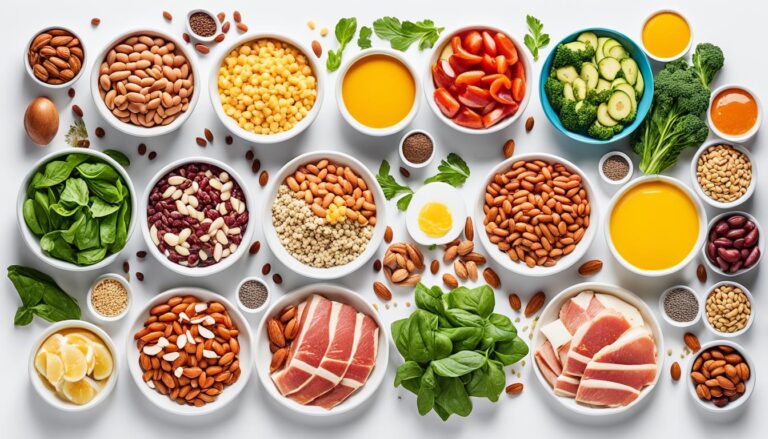Are you ready to explore the world of intermittent fasting? This guide is perfect for both health experts and those just starting out.
It will show you how to boost your metabolism increase your energy, and reach your weight loss goals. Plus you’ll keep your sense of humor.
Get ready to improve your body and mind with this fast-track approach. It’s time to get in sync with your body’s natural rhythms.
Key Takeaways
- Intermittent fasting is a powerful tool for weight loss metabolic health, and longevity
- Understand the science behind time-restricted eating and its benefits
- Explore different intermittent fasting methods to find the best fit for your lifestyle
- Learn how to create a personalized fasting plan for optimal results
- Discover strategies to overcome common challenges and curb hunger cravings
What is Intermittent Fasting?
Intermittent fasting is a way of eating that switches between fasting and eating. It’s not about what you eat but when you eat. This method is popular for its metabolic benefits, like better insulin sensitivity and a healthier circadian rhythm.
The Science Behind Time-Restricted Eating
At its heart, intermittent fasting uses time restricted eating. By eating only during certain hours your body uses stored fat for energy. This can lead to more fat-burning and better metabolic flexibility.
Metabolic Benefits of Fasting
- Enhanced insulin sensitivity, which helps control blood sugar and lowers type 2 diabetes risk
- Increased autophagy a process that cleans out damaged cells which may help you live longer
- Improved circadian rhythm and better sleep wake cycle
- Less inflammation, which is connected to many chronic diseases
Learning about intermittent fasting and time restricted eating helps people make smart choices for their health.

Intermittent fasting is a powerful tool for improving metabolic health and potentially extending lifespan.
Different Intermittent Fasting Methods
Intermittent fasting isn’t the same for everyone. There are many ways to do it each with its own benefits. The 16/8 method and the 5:2 diet are two popular ones.
The 16/8 Method
The 16/8 method means fasting for 16 hours and eating during an 8-hour window. It can boost your metabolism and help burn fat. Eating only during certain hours can also help you eat less and support weight loss.
The 5:2 Diet
The 5:2 diet is a type of fasting where you eat normally for five days and eat very little for two days. On fasting days, you eat about 500-600 calories. This can lead to significant weight loss and improve your metabolism.
Choosing between the 16/8 method or the 5:2 diet depends on what fits your life and preferences. Try different methods to see what suits you best.

Read more: Intermittent Fasting May Be More Effective for Weight Loss
Intermittent fasting is not a one-size-fits-all approach. Discover the unique benefits of the 16/8 method and the 5:2 diet to find the right fit for your lifestyle and goals.
Fasting Intermittent Plan The Key to Weight Loss
Trying to lose weight is tough, but an intermittent fasting plan might be what you need. This method limits your calorie intake. It can boost your body’s fat-burning ability and help you reach your weight loss goals.
Intermittent fasting works by alternating between eating and fasting. This creates a calorie deficit. Your body then uses fat for energy aiding in weight loss and improving metabolic health. This makes it easier to maintain weight loss over time.
| Intermittent Fasting Approach | Potential Benefits for Weight Loss |
|---|---|
| The 16/8 Method | Promotes a calorie deficit by limiting your eating window to 8 hours, allowing your body to burn fat during the extended fasting period. |
| The 5:2 Diet | Combines 5 days of regular eating with 2 days of significantly reduced calorie intake creating a consistent calorie deficit for weight loss. |
Adding an intermittent fasting plan to your life can help you use calorie restriction and fat burning for lasting weight loss. It’s a simple yet powerful way to change your body and enhance your health.

Intermittent fasting has been a game changer for my weight loss journey. The ability to strategically restrict my calorie intake has helped me shed pounds and feel more energized than ever before.
Try the fasting intermittent plan and discover the secret to lasting weight loss. You’re just a few fasting cycles away from a healthier more confident you.
Intermittent Fasting and Autophagy
Intermittent fasting is becoming popular for its health and longevity benefits. It involves eating and fasting in cycles. This method can trigger a process called autophagy.
Autophagy is when our cells recycle and renew damaged parts. It helps cells work better lowers inflammation, and may even make us live longer.
Cellular Renewal and Longevity
When we fast our body shifts to focus on autophagy. This means cleaning and regenerating cells. It can help prevent diseases and make us live longer.
Autophagy is a fundamental catabolic mechanism that involves the degradation of a cell’s own components through the lysosomal machinery. Yoshinori Ohsumi Nobel Laureate in Physiology or Medicine 2016
Studies show that fasting can slow down aging and make cells stronger. The link between intermittent fasting autophagy cellular renewal, and longevity is very interesting.

Read more: Can Intermittent Fasting Compete with Diet Pills?
Meal Planning for Intermittent Fasting
Creating the right meal plan is key to doing well with intermittent fasting. By managing your calorie intake nutrient balance, and meal times, you help your health and fitness goals. This also lets you enjoy the perks of intermittent fasting.
For intermittent fasting it’s important to get enough nutrients. You might plan your meals and snacks to have proteins healthy fats, and complex carbs. Also, watch your portion sizes and calorie intake to keep your eating healthy.
Adding foods full of nutrients to your meal planning helps you stay energized during fasts. Think about eating veggies fruits lean proteins, and whole grains. These foods are good for you and help you reach your health and fitness goals.
Strategies for Optimal Meal Timing
The timing of your meals is crucial with intermittent fasting. Here are some tips:
- Match your eating with your daily activities and schedule
- Try different fasting times like 16 hours fasting 8 hours eating
- Have a mix of meal sizes and how often you eat during your eating times
- Drink water unsweetened teas or black coffee when fasting
Using these ideas in your meal planning can help you get the most out of intermittent fasting. It also supports your overall health and well-being.

Read more: Nourish Your Body with Fruits and Vegetables
The key to successful intermittent fasting is finding a meal plan that works for your individual needs and lifestyle.
Intermittent Fasting and Exercise
The combo of intermittent fasting and exercise is a big win for your health and fitness. Together, they help you burn fat and boost your metabolic health.
Boosting Fat-Burning Potential
Intermittent fasting and exercise work well together. When you fast, your body uses fat for energy. Adding exercise makes this fat burning even stronger.
Research shows that intermittent fasting and exercise together lead to more weight loss and better body shape. The secret is to time your workouts right with your fasting periods.
- Work out during the fasting times to make the most of your fat burning power.
- Try different exercises like strength training HIIT, and cardio to work on various energy systems and get the best results.
- Rest and recover during the eating window to refill nutrients and help muscles grow.
Matching your intermittent fasting and exercise plans creates a strong combo. This combo boosts your fat burning and improves your metabolic health.
Combining intermittent fasting and exercise is a potent strategy for transforming your body and improving your health.
Overcoming Challenges
Starting an intermittent fasting lifestyle can be tough but you can beat the challenges with the right strategies. One big hurdle is dealing with hunger and cravings during fasting. But with a few simple tips you can get past these and reach your fasting goals.
Tips for Curbing Hunger and Cravings
Drinking water is crucial to fight hunger during fasting. Drinking water herbal tea or black coffee can make you feel full and cut down on snacking. Also eating foods rich in nutrients during your eating times can make you feel fuller and less likely to crave snacks.
- Drink plenty of water and herbal tea to stay hydrated
- Opt for high-protein and high fiber foods to promote fullness
- Engage in light exercise or activity to distract from hunger and cravings
- Identify and avoid your personal trigger foods that may lead to cravings
- Practice mindfulness and meditation to manage stress, which can contribute to cravings
Remember intermittent fasting is a journey, and facing challenges is part of it. By using these tips you’ll get better at handling hunger and cravings. This will help you stick with your intermittent fasting plan for the long haul.

Read more: 7 Drinks to Burn Belly Fat
| Challenge | Tips |
|---|---|
| Hunger |
|
| Cravings |
|
Overcoming challenges is all part of the journey to mastering intermittent fasting.
Intermittent Fasting for Metabolic Health
Intermittent fasting is more than a way to lose weight. It can greatly improve your metabolic health. This method has been proven to make insulin work better keep blood sugar stable, and might lower the risk of chronic diseases.
One big plus of intermittent fasting is how it boosts insulin sensitivity. Insulin is key in controlling blood sugar levels. When your body gets better at using insulin it manages blood sugar better. This can help prevent type 2 diabetes.
Also, this eating pattern can help with metabolic markers linked to chronic diseases. It keeps blood sugar stable and cuts down on inflammation. This might lower the risk of heart disease, some cancers, and neurodegenerative disorders.
- Enhances insulin sensitivity
- Regulates blood sugar levels
- Reduces the risk of chronic diseases
Intermittent fasting has emerged as a powerful tool for improving metabolic health, with far-reaching benefits beyond just weight loss.
To get the most out of intermittent fasting, mix it with mindful eating, regular exercise, and a healthy lifestyle. Doing this can help you fully benefit from fasting and keep your metabolic health in top shape.
Personalizing Your Intermittent Fasting Plan
Intermittent fasting isn’t a one-size fits all approach. Your lifestyle preferences, and needs are key to making a fasting plan that works for you. By personalizing your routine you can make it fit your unique journey to better health and well-being.
Think about your daily schedule and commitments. Are you an early bird or a night owl? Do you work long hours or have a flexible schedule? Matching your fasting times with your natural rhythms and duties helps you get the most out of fasting without disrupting your life.
Also, consider your food likes and dislikes. Maybe you love plants or prefer big, protein-packed meals. Adding these to your fasting plan makes it more fun and keeps you on track.
| Personalization Factor | Considerations |
|---|---|
| Lifestyle | Daily schedule work commitments social activities |
| Dietary Preferences | Dietary restrictions food sensitivities favorite meals |
| Individual Needs | Health goals sleep patterns physical activity levels |
Success with intermittent fasting comes from making it fit your unique needs and likes. By balancing your lifestyle diet and goals you can fully benefit from fasting. This leads to a journey of better health and well-being.
The secret of getting ahead is getting started. The secret of getting started is breaking your complex overwhelming tasks into small manageable tasks, and then starting on the first one.
– Mark Twain
Conclusion
Intermittent fasting is a strong choice for better health and weight loss. It’s easy to add to your daily life and brings many benefits. It helps improve your health boost your metabolism, and help you lose weight.
There are many ways to do intermittent fasting, like the 16/8 method or the 5:2 diet. Find what works best for you and your goals. Adding it to a healthy diet and regular exercise can make your body change in amazing ways.
Start your journey with intermittent fasting for better metabolic health lasting weight loss, and a lifestyle that makes you feel great. It might be tough at first, but with the right mindset and this guide you’ll get there.





